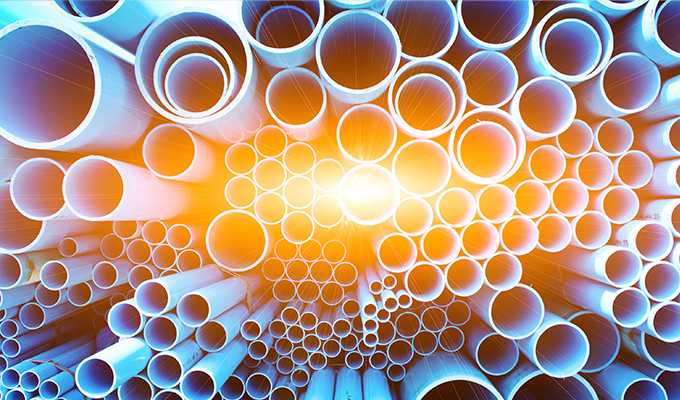By Mark Ligon
CPVC piping is lightweight, strong, and easy to install, making it a great choice for many construction projects. However, even the strongest pipe, if not installed properly, could cause significant damage once the project is complete. Follow these best practices when installing CPVC piping to reduce the risk of pipe failure.
TRANSPORTING AND STORING CPVC
Protecting the integrity of your CPVC piping begins with safe transportation and proper storage. While CPVC piping is quite durable, it does require special care to maintain its strength. Dragging the pipe to its intended location or dropping it unnecessarily, for instance, can increase the chance of cracking or breaking. Proper handling prior to installation is critical to the project’s success.
Once the piping has been transported safely, the next step is to store it properly. Avoid leaving CPVC pipes in the sunlight for long periods of time. Extended exposure to UV radiation could discolor the piping and potentially affect the rigidity of the product. Some brands offer packaging with extra UV protection, but if the CPVC has already been removed from the packaging, be sure to cover it when it is not being installed.
Care should also be taken when storing the solvent cement used to join pipes and fittings. Most manufacturers recommend storing cement at temperatures between 40°F-110°F. In addition, check the date of the solvent cement before it’s used. If it’s been two years since the time of manufacture, it is likely time to throw it away.
INSTALLING CPVC PIPING
Prior to installation, inspect the CPVC piping, looking for any visible signs of damage. If a section of the pipe shows cracking, cut the damaged piece away, including two additional inches on each side of the crack, then wipe away any moisture or debris with a dry cloth. It’s also important to take note of the temperature prior to installation. Most CPVC available today can be installed in colder temperatures, but solvent cement cannot. Check with the manufacturer’s specifications, then follow guidelines for heating and applying the solvent to both pipes and fittings.
A section of CPVC piping is only as strong as the joints formed during installation. For this reason, it’s important to take great care to join pipes and fittings correctly during the installation process. Once pieces are cut to the appropriate size, use a deburring tool to create a beveled edge on the pipe, which will help keep the solvent from being pushed down into the fitting, and then remove any shavings or loose pieces that have fallen into the pipe. Next, check the fit of the pipe and fitting prior to bonding the pieces with solvent cement.
When both the pipe and the fitting are ready to be joined, use a dauber to apply a heavy coat of solvent cement on the outside of the pipe, then to the inside of the fitting. If the pipe is larger than 1 inch, a second coat of cement on the outside of the pipe may be needed. However, avoid applying a new coat of solvent cement over existing dried cement. Next, insert the pipe into the fitting, twist a quarter rotation, and hold in place for 30 seconds. Wipe any excess solvent from the pipe when finished.
After the pipe has been properly joined and installed, follow the curing guidelines set by the pipe’s manufacturer. A variety of factors, including pipe size, temperature, and humidity should be used to determine the cure time for each unique installation. In addition, use hangers and supports as needed to ensure the piping stays safely in place.
ALLOWING EXPANSION AND CONTRACTION OF CPVC
Both expansion and contraction are common in CPVC piping. Movement typically comes with a significant change in temperature and occurs most often in hot water lines—though cold-water lines can also be affected in extreme temperatures. Expect 1-inch of expansion for each 50-foot length of straight piping for every 50°F change in temperature.
These potential changes in piping should be accounted for in the installation process. Avoid restricting the natural movement of the pipe, as it may expand or contract, and always leave enough space between restraints and hangers. If the piping is being installed under the slab, position it to snake from side to side to allow for the change in size overtime.
PREVENTING CPVC PIPE FAILURE
A failing CPVC pipe could cause extensive damage to homes and businesses. For this reason, it is critical that manufacturer guidelines are followed closely throughout the installation process. This is especially important when working on any lines that may be exposed to chemicals. While CPVC piping is resistant to a wide variety of common household chemicals, it may not hold up to things like fire retardants commonly found in some fire sprinklers.
Another important consideration is utilizing proper freeze protections for the CPVC piping being installed. Follow the manufacturer’s guidelines, as well as local building codes concerning piping. In addition, avoid installing CPVC in any location where insulation or other freeze protections are not available.
CLOSING THOUGHT
CPVC piping is commonly used by contractors looking for a strong, lightweight product and a simple installation process. However, considerations should be taken to maintain the strength and integrity of the pipes. Avoid dragging pipes onsite, and store out of direct sunlight. Then, follow the piping and solvent cement manufacturers’ guidelines when joining pipes and fittings. Allow for expansion and contraction in the installation, and consider any chemical reactions that may occur. Following these best practices will significantly reduce the risk of pipe failure and maintain the integrity of the construction.
about the author:
Mark Ligon is the marketing manager Commercial Industrial Supply, a leading supplier of commercial PVC and CPVC pipe, fittings, and valves. Mark enjoys educating businesses on the parts of piping systems so managers can make informed decisions.
Modern Contractor Solutions, December 2020
Did you enjoy this article?
Subscribe to the FREE Digital Edition of Modern Contractor Solutions magazine.



